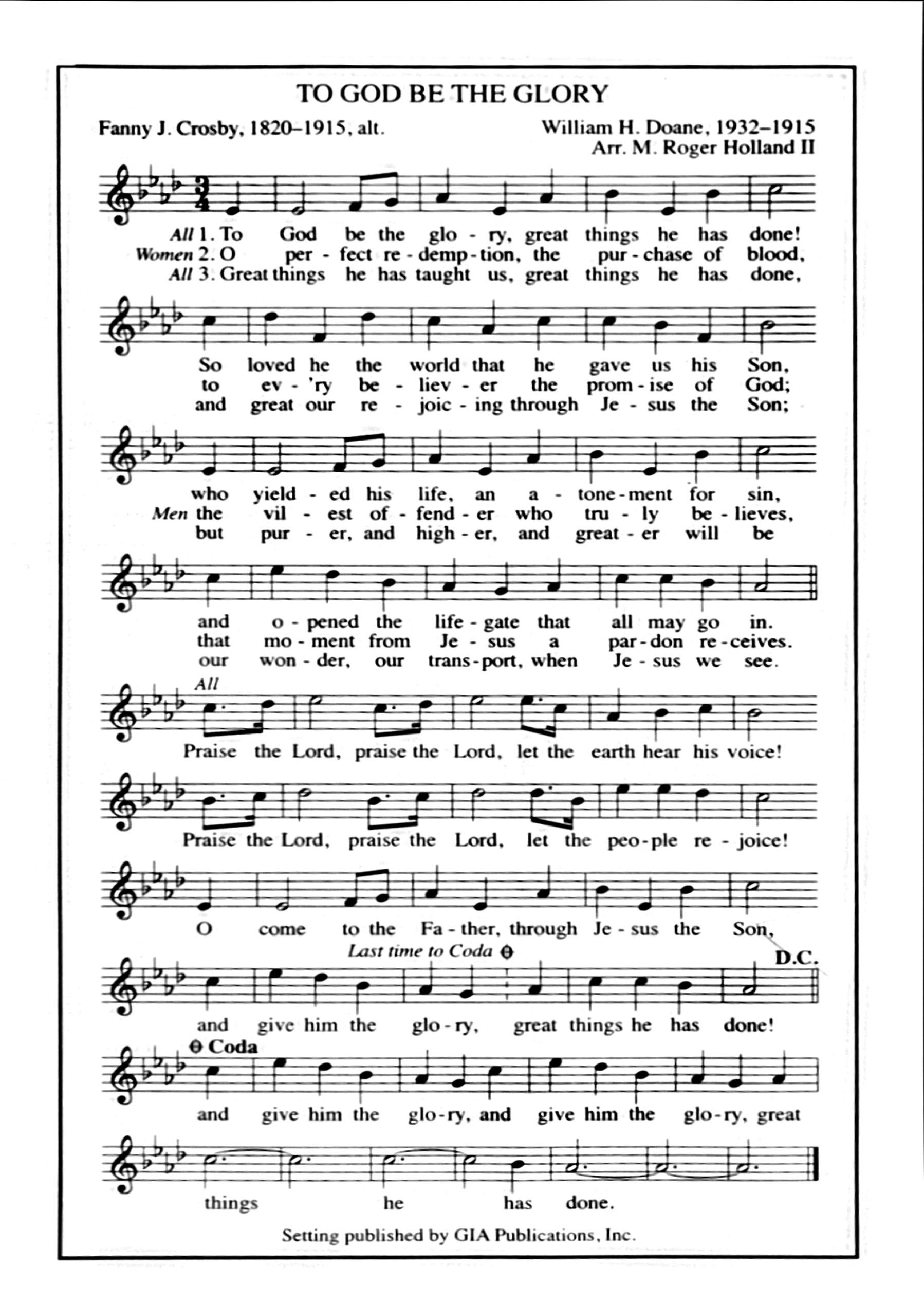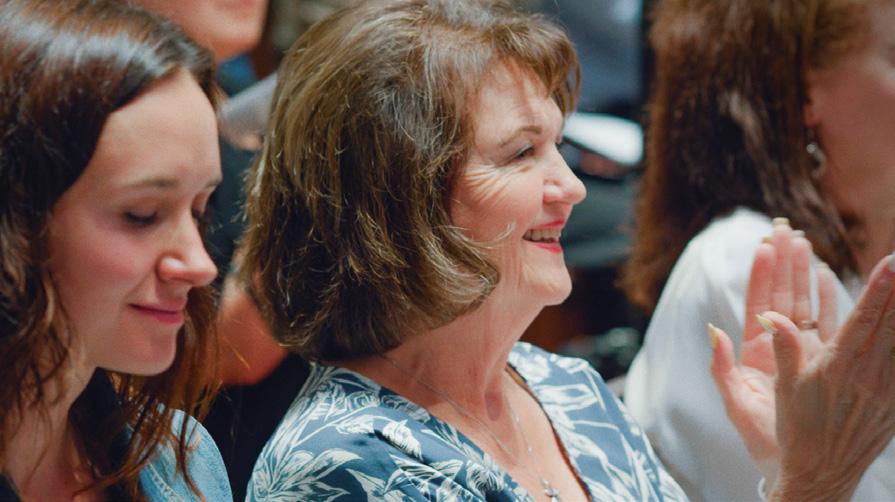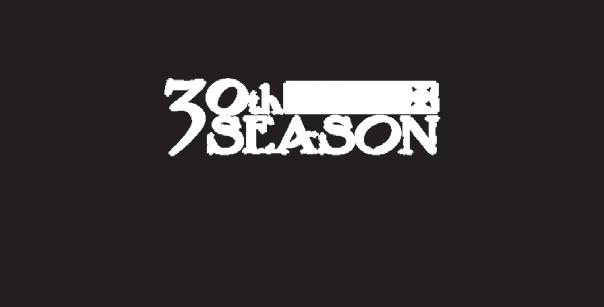
05.17.2024 05.19.2024



05.17.2024 05.19.2024


This


sponsored in part by : &

Shannon Lemmon-Elrod, soprano
MAGNIFICAT
Sarah Branton, contralto - - INTERMISSION --
WILLIAM H. DOANE (1832-1915)
arr. M. Roger Holland, II
UBUNTU: I AM BECAUSE YOU ARE
World premiere. Commissioned by Kantorei; Joel Rinsema, Managing Artistic Director
1. HARMONY
2. DECONSTRUCTION
3. HATE
4. THE WAY BACK
Lester Lynch, baritone
5. UNITED WE STAND
Judah Walker, tenor; Riley Jayne Gallivan, soprano
To make a general contribution to Kantorei, text “ Kantorei ” to 44321 Thank you!



This piece is one of my early commissioned works, requested by high school music teacher William J. Naydan for his choir at Hasboro-Horsham High School in Pennsylvania. My intent with this work was to write something fun and energetic for high schoolers. The piece is rhythmic and makes use of imitation as well as chord clusters built on the interval of a fourth.
The message of the text suggests that it is not helpful to focus on issues of the past that can weigh us down. We can learn from the past without being bogged down by past mistakes or regret. Rather, let us focus on the here and now and treat each moment as a gift. In other words, a present (a deliberate play on words).
I learned this hymn when I was young, playing the piano and organ in church. For many, this hymn has a place among the most beloved hymns sung in worship settings. One of my fondest memories is of the hymn singing in Bristol Chapel as a student at Westminster Choir College in Princeton, New Jersey. It was always wonderful. Everyone sang. Sopranos were ever ready to sing a descant on the final stanza and the organ introductions, interludes, and modulations were grand, uplifting, and exhibited the highest standard for organ playing. Another instance of inspired hymn singing I’ve had the good fortune to experience has been at the Hampton University Ministers’ Conference that convenes jointly with the Choir Directors & Organists’ Guild Workshop. The opening session always included a hymn which everyone in the congregation sang heartily, ably supported by some of the nation's most accomplished organists. Though I am not an organist, I appreciate the support and colors the organ is capable of in supporting congregational song. It is this experience I sought to create with this hymn concertato.
A hymn concertato is a hymn arrangement in which the singing of the congregation is meant to be enhanced by the choir along with organ accompaniment and instruments, often brass and percussion, and especially timpani. It is not an anthem which is written for choir, but rather, is intended for congregational singing enhanced by instruments and the arrangement itself. Often such arrangements are grand and intended to heighten the singing of the gathered assembly of well-known hymns.
This particular hymn concertato was written for Calvary Baptist Church in Jamaica, New York, on the occasion of their 75th church anniversary. I began writing the arrangement fully intending to incorporate brass and likely timpani for this auspicious occasion. Standard instrumentation for my hymn arrangements would include two trumpets and two trombones, sometimes an additional one of either or both. This arrangement grew to include a brass octet – 3 trumpets, 3 trombones (either bass trombone or preferably tuba for the acoustical depth) and 2 French Horns.
The French Horns were added because the pastor at Calvary requested Beethoven’s “Hallelujah” from his oratorio Christ on the Mount of Olives (Christus am Ölberge) to be sung for the church anniversary. The choral work by Beethoven is challenging, especially for the average church choir. Since the choir was to perform this work for the anniversary service, for which brass, including French Horns, would be hired to accompany the Beethoven, I felt it necessary to have additional music to play beyond that one work for the Horns. I then added them to the arrangement, with a very prominent part in the coda section, idiomatic of French Horns playing a “call” with open fifths.
Another feature of this setting reflects my experience of singing hymns at Westminster. Rather than sing every verse with the same texture, often when singing hymns with multiple verses we would alternate the vocal forces. We alternated between unison verses for the first and last stanza (with a descant on the last verse), women only or men only on certain stanzas, voices in harmony with organ accompaniment or unaccompanied, or even alternating between groups sitting on opposite sides of the chapel for an antiphonal effect.
The more stanzas a hymn had, the more variety we could expect in the singing. I desired to bring some of this variety to the church experience. However, this hymn has only three stanzas, so albeit briefly, the women and men split the singing of stanza two. The final stanza has what I would call an intermittent descant as the sopranos alternate between singing the melody and an obligato part above the melody.
The inspiration for this piece came from my daily devotional prayer. The resource I was using at the time had a scripture reference that was then reflected on by the writer for that particular day. The scripture on this day was Psalm 34, and the focus verse was verse 19 – “Many are the afflictions of the righteous: but the LORD delivers him out of them all.” In using this text, I went to the King James translation, though for a couple of words, such as “delivereth” in verse 19 I used a more modern rendering of the word. When the same word appears in verse 17, I decided to go with the Old English of the Kings James Version. The decision to use two different versions of the same word was purely artistic. “Delivers” worked better for me in the opening statement. “Delivereth” worked better later in the piece when setting verse 17. (The New King James Version renders the word as “delivers” in verses 17 and 19.)
Program notes by M. Roger Holland, II
In my compositional process I very rarely make a deliberate decision to compose in one genre or another. I usually allow the text to dictate how the music should sound. For some reason (some may call it Divine inspiration), I was moved to set the text in what I feel is the style of a Renaissance motet, such as those composed by Giovanni Pierluigi de Palestrina (1526–1594), Orlando di Lasso (1532–1595), and Tomás Luis de Victoria (1548–1611), all of whose music I have sung. I had not written a piece in the style of a motet before nor have I since. Something about this text in the moment seemed to call out for this ancient style, and I looked forward to writing something in this Renaissance imitative style.
While seeking to write something in the style of Palestrina or di Lasso, I did not feel bound to the harmonic vocabulary of the period, but rather, to use harmonic language that felt right for me – the language of African American idioms. There are complex chords such as the C7 #9 chord and C flat 13 chord found at the end of the “C” section on the first syllable of the word “delivereth.” There are unexpected modulations such as the one from D minor to Eb major in the “D” section where I use a secondary dominant chord (V7 of G) that instead of the typical resolution to G minor resolves to F minor which is the ii chord and then the dominant V chord in the key of Eb major.
The piece ends as it begins, with the statement of the key text – Psalm 34: 19, “Many are the afflictions of the righteous: but the LORD delivers him out of them all.” In the opening statement the final cadence is what theorists would call “imperfect” because the lowest pitch of the chord is not the tonic. This can give the chord a feeling of being unsettled or not completely at rest. This feeling of being incomplete or not yet at rest can cause the listener to want to hear more, as the phrase did not end in a way
that provided a satisfactory conclusion. When the opening statement recurs at the conclusion of the piece, the tonic of the chord is finally placed in the lowest note of the chord, giving it a sense of finality or being at rest.
This piece was commissioned by the University of Kentucky Women’s Choir at the behest of their director, Dr. Lori Hetzel. It is the second of two pieces commissioned by Dr. Hetzel for the Women’s Choir, both with the intention of being performed and premiered at two separate gatherings of the national conference of the American Choral Directors Association (ACDA).
For this second commission for the women, I selected a Negro Spiritual. “Anchored in the Lord” is one I first heard as arranged by Florence Price (1887–1953), which she wrote for famed contralto Marian Anderson (1897–1993) on the occasion of her recital at the Lincoln Memorial in 1939, this, after the Daughters of the American Revolution refused to allow Anderson to perform at Constitution Hall in Washington, D.C. because of her race. Later, I was exposed to the arrangement of this Spiritual by Moses Hogan for choir. Both of these arrangements informed my own arrangement.
I conceived of the way the piece would end first, from the polyphonic section that builds in the middle starting with the Bass section of the choir, wanting to culminate with a big ending, and then needed to figure out how to arrive at this place. After Dr. Hetzel later asked for a published version of the score to share at a conference that the Kentucky Women’s Choir was performing at, I contacted my publisher, GIA Publications, Inc., and started the process for publication. I decided, however, to re-score the piece for mixed choir, thinking an SATB arrangement
may illicit greater interest than an arrangement for women’s choir. The key was lowered one half-step from its original key and some re-voicing was done to make the arrangement more conducive for mixed voices. The solo soprano part was envisioned for a soprano with a good top range, potentially for a coloratura, but certainly for a big voice.
There is intermittent use of Negro dialect (the dialect of English spoken by the enslaved as they interpreted the English language as spoken by their oppressors). My use of dialect when it appears is to facilitate the singing voice in certain sections of the piece where I find that English consonants interfere with a free vocal sound and ease of phrase. This is an interpretive decision informed by vocal technique, African American idioms, and cultural, historical, and contextual ideological thought.
I have at times been accused of being too literal in my artistic imaginings. For this piece the thought occurred to me to include the sound of an anchor. Though the work is a cappella (unaccompanied), the instrumentation of an anvil is added, to evoke the sound of an anchor. For me, the metallic sound of the anchor (played on an anvil being struck by a hammer or hard metallic object) represents not only the anchor of slave ships that carried thousands of enslaved Africans to these shores, but also the sound of the chains used to bind and imprison them.
In the text of the Spiritual itself, the metaphor of the anchor represents the grounding of the religious faith of the enslaved. Not only their Christian faith, but their faith in a God who would deliver them from the chains of bondage and set them free, just as God had done for the Israelites in Egypt as recorded in the book of Exodus.
Program notes by M. Roger Holland, II
The Magnificat is an ancient text that is used in the Liturgy of the Hours, also known as the Divine Office. It is specifically used during evening prayer, also called Vespers. The text of the Magnificat, also known as the Song of Mary, is taken from the Gospel of Luke (1:46–55), and are the words spoken by Mary in reply to her cousin Elizabeth’s salute to her status as the favored handmaid of God. Various composers have set this text, such as Johann Sebastian Bach (1685–1750), Claudio Monteverdi (1567–1643), Antonio Vivaldi (1678–1741), Anton Bruckner (1824–1896), Sergei Rachmaninoff (1873–1943), and John Rutter (b. 1945). Very often, because of the length of the text, composers have set the canticle as multiple individual movements within one work. Bach and Vivaldi’s settings are examples of this multimovement approach.
As an admirer of the work of both Bach and Vivaldi, I modeled my concert setting of this work after aspects of these two composers. Vivaldi’s Magnificat begins with an Adagio tempo for the beginning text. I used this example to fashion the opening section of my setting in a baroque style set in Latin. The piece then moves into a faster Allegretto tempo set in English. I sang the Bach Magnificat as a member of the world-renowned Boys Choir of Harlem when we performed the work with the Orchestra of St. Luke’s at Lincoln Center.
The choir is scored for five-part mixed choir (two sopranos, alto tenor, and bass). The orchestral parts are scored for two oboes, three trumpets, bassoon, timpani, strings and basso continuo (usually consisting of organ along with cello and double bass). I wanted to emulate this baroque orchestration in my setting, but rather than two oboes, I chose to write for one oboe paired with the soprano sax. A basic SATB choral setting is used rather than two-part sopranos. (More
practical for today.) Three trumpets felt excessive for my use and so I paired that down to two trumpets along with two trombones, reflecting my penchant for brass. I toyed with the idea of both pipe organ and use of the Hammond organ for the concluding gospel section. Depending on performance venue and opportunities, both of these instruments may be added. The current orchestration uses the piano to function as the harmonic keyboard instrument for the work. Timpani, and rhythm section, inclusive of electric bass and drums, further support the concluding gospel section.
One will hear influences of the baroque writing of Bach and Handel, and certainly Vivaldi in the Adagio sections. There is a brief moment of Mozart and a touch of the romantic period, along with some 20th century writing with meter changes. Before the recapitulation of the Adagio section for the concluding Gloria Patri text in Latin there is a recitative for mezzo soprano, reminiscent of baroque/classical oratorio. After the Gloria Patri statement in the Adagio Latin there is a baroque-style fugue of the Gloria Patri in English (“Glory be to the Father, and to the Son, and to the Holy Ghost”) that is interrupted with the inclusion of text from the Gloria in excelsis Deo (“Glory to God in the highest”) used in the Catholic Mass. I am fond of the litany of praise that occurs early on in the Gloria text – “We praise you, we bless you, we adore you, we glorify you, we give you praise for your great glory.” The work concludes with a gospel vamp in contemporary gospel style using the last line of the Gloria Patri text.
The piece was commissioned by Dr. Anthony Leach for the group Essence 2, a choral ensemble comprised of former members of the Penn State choral group Essence of Joy which focuses on repertoire of the African American experience. It was Dr. Leach’s suggestion to set the text of one of the ancient church texts. It was premiered by Essence 2 in 2019.
This work commissioned by Kantorei to be premiered at the conclusion of our three-year collaboration is the first major, multi-movement work I have written in the Western classical idiom since my first commissioned work, The Dream and The Dreamer, commissioned by New York City not-for-profit group RejoicEnsemble! by its conductor, Carl MaultsBy. The Dream and The Dreamer was funded by a grant from the New York State Council on the Arts (NYSCA), jointly applied for by groups RejoicEnsemble! and the Quintet of the Americas, a professional woodwind quintet also based in New York City. The piece was therefore written for the 5-part vocal ensemble, rhythm section with percussion at the request of group RejoicEnsemble!, and woodwind quintet.
My idea for the Kantorei commission stemmed from an earlier composition, “Hate,” which is included as the third movement of this work. “Hate” was written during my time as a seminary student at Union Theological Seminary in New York City. While a seminarian at Union, I had occasion to take a course on slave narratives with womanist theologian Dr. Katie Cannon (1950–2018), herself a Union alum and the first African American woman to be awarded the Ph.D. at Union Theological Seminary and the first African American woman to be ordained in the United Presbyterian Church (U.S.A.). The course was very intense and the reading of slave narratives in such volume had a very emotional impact on me, such that I found myself very reflective and at times depressed. Dr. Cannon had a practice of meeting with her students regularly over lunch after class. At one such gathering in conversation with Dr. Cannon, I shared how I was wrestling with the course work and the subject matter. In the class meeting before lunch that day a student in class shared how she had attended a gathering at the Interchurch Center that
included some veterans. These veterans shared how they were trained to kill their enemy, and how that consisted of viewing other people as non-human. In this way, they were more easily able to kill someone whom they now deemed not human. Along with the stories of the slave narratives we engaged with every class I found myself overcome with despair at this level of inhumanity. I shared this with Dr. Cannon over lunch that day. Dr. Cannon suggested that as a musician I should write a piece to express how I was feeling. I found this exercise very cathartic. “Hate” is the result of this exercise. After composing the piece, I found myself desiring to compose a larger work, one that would explore how we as human beings can designate other human beings as “other,” stripping them of their humanity, such that one is able to hate another even to the point of killing them without remorse, guilt, or conscience. In other words, how can we devolve to the point of hating someone? Then, I would need to explore the path toward redemption. How can we “de-otherize” those whom we have stripped of humanity? Joel Rinsema and Kantorei provided me the opportunity to realize this vision in what has become UBUNTU.
I call the piece "Ubuntu," an African word that is often translated as "I am because we/you are," because it speaks to our interconnectedness as human beings and as community. I sought out someone to write the text for the work, leaving me free to engage solely as music composer, and found that person in a fellow Union alum and pastor of Broadway Presbyterian Church in New York City, Chris Shelton. We had an initial conversation about by desire to write this large-scale work and the offer of the commission from Kantorei. I shared with Chris my dream and vision of the work and together we found that we had a kinship and shared thoughts about humanity and care for others. I have found our collaboration to be fruitful and rewarding.
The first movement, “Harmony,” was inspired by Psalm 133:1 – “Behold, how good and pleasant it is when people live in harmony.” In this movement Chris and I explore a rather utopian vision of a world where people dwell in a state of perfect community, harmoniously, where the Divine intention of unity is echoed in a melody, one so ancient, that if we listen carefully will find that its tune still resonates within our world. This “ancient melody” takes on the characteristic of a recurring motif that symbolizes the ideal of true community and humanity as the Creator intended. It helps bind the various movements and appears in every movement except for the fifth and final movement.
From a theological standpoint, the division between people in the world is the result of an infection that the Bible would call sin. Sin is that which divides us and causes separation, separation between humanity and God separation between one another. Some of the manifestations of this separation can be found in things such as jealousy, fear, distrust, ignorance, and selfishness. When these emotions take over, become dominant and consume us, the soil of our hearts become fertile for hate to take root.
The second movement, “Deconstruction,” explores what can happen when we allow ourselves to listen to the voices of fear, selfishness, and ignorance rather than of love for one another and allow those voices to become dominant and consume us. The music uses a double chorus to illustrate the two ideals in tension. The music also uses dissonant harmonies and unsettling rhythms and meters to manifest this tension, but never losing hope as the “ancient melody” struggles to remind us of the possibility of love and community.
Program notes by M. Roger Holland, II
The third movement, “Hate,” is the resultant that occurs when we allow the basest of instincts to become the dominant voice in our minds and hearts. Yet still, “the ancient melody” offers us a glimpse of hope and the possibility of regaining our humanity and the ability to once again see the humanity in others.
The fourth movement offers us “The Way Back,” a path forward and to reclaim our own humanity as we acknowledge the humanity in others. This movement begins with a recitative and aria for baritone solo and is later joined by the choir, though the two never sing together. The movement begins with the voice of the “other” responding to the hate he has just experienced, questioning “why” things have gotten to this place and asking the question, “what have I done” to deserve such utter disdain. The aria begins by declaring that “Hatred is a lie, persuading us we’re enemies,” and challenging us to see the humanity in those whom we’ve “othered.”
The choir acknowledges the cruelty and viciousness of hate but invites us to hear the voice and melody of love instead. Indeed, the truth of love can break the bondage of hate and restore the bonds capable of rebuilding the community that was always the great design. The fourth movement ends with an affirmation of community with a “Unity Chant.”
The word ‘unity’ is sung over and over, layered in twelve different languages, including Latin, Hebrew, Arabic, Italian, French, Spanish, German, Korean, Japanese, Chinese, Swahili, and Portuguese. Melodies of Negro Spirituals, the religious folk music of the enslaved and created in community, concludes the movement played by the trumpet, trombone, and flute respectively.
The fifth movement was pre-composed as a response to the 9/11 tragedy of 2001 and is used to conclude this work. “United We Stand” is a message that articulates the power of love to overcome the division that fear, resulting in hate, seeks to sow. It encourages us to embrace love and the best of who we are as human beings, further reinforcing the ideology of unity and community. The style of this movement is that of an R&B ballad and different from the other movements stylistically, yet the message of love and unity serve to connect it to the rest of the work. It also represents an aspect of the diversity of styles that are a part of my musical influences and comprise who I am as a musician, composer, and artist. The vocal writing for the choir in the concluding coda section reflects the influences of Mervyn Warren, producer, songwriter and arranger, formerly of gospel-jazz group Take 6, and the background vocal arranging skills of legendary R&B artist Luther Vandross.
This well-known “Peace Prayer” has been attributed to St. Francis of Assisi (1181–1226). In fact, the actual author is unknown. The prayer first appeared in France in 1912 in a small spiritual magazine called La Clochette (The Little Bell), published in Paris by a Catholic association known as La Ligue de la SainteMesse (The Holy Mass League). The inspiration for this setting of the Peace Prayer was in fact twofold. At the time, I was working on a recording project with the choir at my home church, Our Lady of Charity RC Church in Brooklyn, New York. I was working on composing original material myself, as well as seeking out pieces by other composers. Around this period, the father of a dear friend of mine, Brother Tyrone Davis, passed away. Br. Tyrone asked me to play at the Funeral Mass of his father, James E. Davis, to which I of course, agreed. As is the custom at
Program notes by M. Roger Holland, II
many funerals, something called palm cards were distributed to the attendees to memorialize the deceased. They often have photos of the deceased or some uplifting picture like a dove on one side, and on the opposite side there may likely be a short biography, poem, prayer, or inspirational saying. In this case, it was the Prayer of St. Francis (attributed to Francis). I was familiar with the prayer and had heard it before, but something struck me about it in that moment, perhaps because I was in “composing mode” for the church choir recording, but my ear and brain recognized a musical quality to the text, and I immediately heard a tune for the text. Before I returned home, I had composed the first half of the setting, writing in shorthand the melody and words on some scrap of paper.
What struck me about the text was its coupled structure; in the first section dialogical opposites, and in the second, the extension of ideas that moved from need to service. I also saw this musically as calland-response. The text demanded (for me) to be structured as musical phrases in dialogue with each other – question/answer or antecedent/consequent phrases. As the text changes from dialogical to what I feel is the more powerful “need to service,” it dictated a musical structure that mirrored this textual and ideological shift. Hence, the key change. The way the word “joy” is set in the first half is my way of conveying the quiet joy that is internal, often emotional, when one is overcome with joy like when experiencing a great act of kindness or love.
Overall, the musical setting is a reflection of my musical exposure and training as a classically trained musician who also has experiences with jazz, R&B, and especially gospel music. This piece may be seen as a hybrid between classical music and gospel idiomatic expressions.
Our Mission:
Kantorei is an inclusive community of volunteer singers that invites audiences to experience the richness and diversity of the choral art form, joyously executed at the highest standard of musical excellence. We are innovators: we responsibly leverage our resources to commission work by living composers, perform music by underrepresented and emerging artists, encourage future talent through educational engagement, and nurture the choral community.
Our Values:
Musical Excellence – We maintain the highest possible standards. We hold ourselves and each other accountable for putting in the necessary effort. We take on artistic challenges that many choirs cannot. We provide our audiences with unique musical experiences performed with professionalism, accuracy, passion, and finesse. We are a volunteer choir with world-class aspirations and achievements.
Inclusion – We strive to create a singer community where individuals from all backgrounds and experiences can be their best. We celebrate and perform composers that have been underrepresented in the choral tradition alongside those who have historically enjoyed the spotlight. We amplify voices that should be heard, and seek to bring our voices to new places. We connect diverse audiences through the power of music.
Joy – We make music because it brings us joy and we are passionate about sharing that joy with others. Audiences feel our connection to each other and the music; through our work they experience intellectual and emotional expansion. Sharing this joy with each other and our audiences is a privilege.
Community – We provide an opportunity for singers, artists, students, and audiences from many different backgrounds and identities to share in musical experiences that allow us to transcend the world we live in. Our singers show up for each other, both musically and personally. We are in community with the composers who partner with us. We create nurturing relationships with other choirs so we can collectively thrive. We show young and emerging artists what their musical future can look like.
Innovation – As an organization, we are never stagnant. We feel a responsibility to use our funding to educate, delight, and amaze, which is evident through every aspect of our work: programming, recordings, concerts, and community impact. We move the art form forward by celebrating the full diversity of modern choral composition, and juxtaposing it with treasured work of the traditional canon. Our audiences can feel the musical past resonating with wisdom in the present, and the present reaching back to seek guidance from the past.

Land acknowledgement
Kantorei honors and acknowledges the Tséstho’e (Cheyenne), hinono’eino’ biito’owu’ (Arapaho), Núu-agha-tʉvʉ-pʉ̱ (Ute), and Očhéthi Šakówiŋ (Sioux) Tribes, and all of the original Indigenous peoples of the land upon which we rehearse and perform.

Joel M. Rinsema joined Kantorei (Denver, Colorado USA) in 2014, becoming the second conductor in its 25-year history. During his tenure, Kantorei has experienced tremendous audience growth, nearly tripled its budget, and launched an ambitious recording strategy. A frequent collaborator and champion of new works for chorus, Joel has commissioned and premiered works by many of today’s leading composers, including Kim André Arnesen, Mason Bates, René Clausen, Jean Belmont Ford, Ola Gjeilo, Jocelyn Hagen, Mark Hayes, Cecilia McDowall, Sarah Quartel, Jake Runestad, Christopher Tin, and Eric Whitacre.
In the summer of 2022, Joel conducted the Central American premiere of Jake Runestad’s El Último Hilo (The Last Thread) in Guatemala City and Antigua, Guatemala with Kantorei and the Guatemalan choir Vocalis. He returned in May of 2023 to conduct Eric Whitacre’s The Sacred Veil and serves as Artistic Advisor and Principal Guest Conductor of Vocalis.
Under Joel’s direction, Kantorei has released two recordings on the Naxos label. Sing, Wearing the Sky: Choral Music of Jake Runestad (2020) was the #3 best-selling classical album on iTunes, reached #4 on the Traditional Classical Billboard Charts, and was in the top ten in both the best-selling classical album and new classical release categories on Amazon. Infinity: Choral Works of Kim André Arnesen (2018) climbed to the #2 best-selling classical album on iTunes, #6 on the Traditional Classical Billboard Charts, and #19 on the overall Classical Billboard charts. Santa Barbara Music Publishing Inc., publishes the Joel Rinsema / Kantorei Choral series.
Joel led Kantorei in performances at the 2019 National Convention of the American Choral Directors Association, and has prepared Kantorei as the primary chorus for the Aspen Music Festival, with Maestro Robert Spano conducting, in the summers of 2021 and 2022. More recently, he conducted Kantorei along with the Canadian Brass in December of 2022, and commissioned and prepared Kantorei for the world premiere of the string orchestra version of Eric Whitacre’s The Sacred Veil, conducted by the composer, and guest conducted The Sacred Veil with the Washington (DC) Choral Arts Society in May of 2023.
A passionate advocate for the professional choral art form, Joel frequently consults with choral arts organizations around the country. Because of his leadership in his field, he received the Louis Botto Award for “Innovative Action and Entrepreneurial Zeal” from Chorus America, the industry’s advocacy, research, and leadership development organization for choruses, choral leaders, and singers.
Joel is an accomplished conductor of major works for choir and orchestra and was one of eighteen conductors chosen nationally through audition to participate in master classes and workshops presented by the Chicago Symphony Orchestra Association and Chorus America. As a tenor soloist, Joel performed across the United States as well as in Germany, Austria, and the Czech Republic.
Joel also serves as Director of Music and Technology in Worship at First Plymouth Congregational Church in Cherry Hills Village, Colorado. He was also the North American Choral Promotion Manager for Oxford University Press based in Oxford, England from 2017 to 2020, a tenure during which he worked closely with and represented roster composers John Rutter, Mack Wilberg, Bob Chilcott, Sarah Quartel, Cecilia McDowall, Gabriel Jackson, and Will Todd among others.
He holds music degrees from Arizona State University and Whitworth University and is a member of the Academy of Recording Arts and Sciences (Grammys), and the American Choral Directors Association (ACDA).
Joel came to Kantorei from the Grammy Award-winning Phoenix Chorale. Throughout his 23-year tenure with the Phoenix Chorale, he served in nearly every capacity with the organization, including his last 15 years as President & CEO and Assistant Conductor. He negotiated an ongoing recording contract with the prestigious U.K.-based Chandos Records, and Phoenix Chorale recordings received a total of eight Grammy nominations and two Grammy awards during his tenure. Joel appears on all Phoenix Chorale recordings and was a soloist on the Grammy Award-winning “Spotless Rose: Hymn to the Virgin Mary.” In addition to his work with the Phoenix Chorale, Joel served as the Director of Music at Church of the Beatitudes United Church of Christ in Phoenix for 15 years, and he was the founding chorus master of the Arizona Musicfest Chorus.
He and his wife Sarah Branton (Choir Director at Cherry Creek High School) and stepson Simon Harrison live in Centennial, Colorado along with their miniature Dachshund Lucia. They enjoy all that Colorado has to offer outdoors, including camping, fishing, golfing, and snow skiing.

Kantorei is a Denver-based, choral ensemble comprised of volunteer singers under the direction of Managing Artistic Director Joel M. Rinsema
Formed in 1997 under the leadership of six friends and artistic director Richard Larson, Kantorei has established itself as one of the nation’s premier choral ensembles. Our choral artists have studied at schools with strong music programs across the United States such as Baylor University, Brigham Young University, Eastman School of Music, Indiana University, St. Olaf College, Wartburg College, and Westminster Choir College. Kantorei’s singers reside throughout the greater Denver area. Some serve as choral music educators, church choir conductors, and vocal instructors. Others are doctors, social workers, optometrists, counselors, clinical psychologists, accountants, realtors – all brought together in weekly rehearsals for shared artistic excellence and community.
Kantorei has performed for major choral conventions across the U.S. and with The Aspen Music Festival, toured the world, and has commissioned and premiered new choral works from such renowned composers as Kim André Arnesen, Eric William Barnum, Abbie Betinis, René Clausen, Ola Gjeilo, Jocelyn Hagen, Sarah Quartel, Jake Runestad, Joshua Shank, and Eric Whitacre. In the summer of 2022, Kantorei performed the Central American premiere of Jake Runestad’s “El Último Hilo” in Guatemala City and Antigua, Guatemala, along with Guatemalan choir Vocalis. In the fall of 2021, Kantorei began its three-year collaboration with M. Roger Holland, II as Artist-in-Residence.
Kantorei has released two recordings on the Naxos label. “Sing, Wearing the Sky” (2020) choral music of Jake Runestad reached the #3 best-selling classical album on iTunes, #4 on the Traditional Classical Billboard Charts, and the top ten in both the best-selling classical album and new classical release categories on Amazon. “Infinity: Choral Works of Kim André Arnesen” (2018) climbed to the #2 best-selling classical album on iTunes, #6 on the Traditional Classical Billboard Charts and #19 on the overall Classical Billboard charts. Santa Barbara Music Publishing Inc. publishes the Kantorei Choral series. In early winter 2025, Kantorei will once again join forces with Grammy-winning producers Soundmirror to record choral works of Grammy-winning composer Christopher Tin, this time on the Decca label.
Kantorei’s vision is “to elevate the human experience through choral excellence.”
“Thank you for the joy you have brought into my life.”
“I've been smiling all day long. I'm so glad I got to experience the beauty of Kantorei's performance. It was truly heartwarming.”
“What an incredible experience…words cannot convey the magnitude of the program…spellbinding. Not soon to be forgotten.”
Victoria Bailey
Beryl Fanslow Wilson
Riley Jayne Gallivan
Christina Graham
Heather Gunnerson
Stacie Hanson *
Becca Hyvonen
Shannon Lemmon-Elrod
Sara Michael *
Lexie Orvin
Martina Richardson
Alicia Rigsby ◊
Pearl Rutherford
Christianna Sullins
Leah Tracy
Safia Ahmed
Emily Alexander
Lindsey Aquilina
Lyn Berry-Helmlinger
Sarah Branton *
Desiree Deliz-Morales
Erin Greenfield
Melissa Menter
Erin Meyerhoff
Jennifer Moore
Allison Pasternak *
Kaleigh Sutula
Andrea Ware-Medina
Jane Wright
Violin I
Chris Leonard
Concert Master
Autumn Pepper
Olasuyi Ige
Violin II
Emily Lewis
Lee Blackmore
Viola
Allyson Stibbards
Aimee McAnulty
Cello
Dave Short
Erin Patterson
Double Bass
Peter Huffaker
Electric Bass
Wyatt Ware
Flute
Sonya Yeager-Meeks
Sarah Branton
Assistant Conductor
Alicia Rigsby
Accompanist, Collaborative Pianist
Sara Michael
Business Manager
Oboe
Kai Berry-Helmlinger *
Ben Corwyn
Joshua Corwyn
Matthew Eschliman
Mason France
Keith Harrison
Bryce Kennedy
Samuel Low
Alex Menter
Chad Nelsen
Seth O'Kegley *
Zachariah Smith
Jonathan Von Stroh
John Wright
Ricky Arellano
French Horn
Spencer Koscik
David Smalley
Trumpet
Adam Warnke
Dawn Kramer
Ian Sawyer
Trombone
Nat Wickham
Craig Hull
Bass Trombone
Patrick Kavanaugh
John Bartley
Michael Bizzaro *
Jordan Black
Adam Cave
Garth Criswell
Scott Horowitz
Brad Jackson
Brad Larson
Bryan Lastrella
John Ludwig
John Schaak
Kirk Schjodt *
Griffin Sutherland
Matt Weissenbuehler
Soprano Saxophone
Benjamin Porter
Harp
Janet Harriman
Becca Hyvönen
Timpani & Percussion
Mike Tetreault
Drums
Lonnie Christian, Jr.
Piano
M. Roger Holland, II
Alicia Rigsby
Organ
Benjamin Corwyn
Social Media Marketing & Communications Manager
Courtney Huffman Director of Community Engagement
Ximena Wheeler
Concert Manager
Jennifer Moore President
John Bartley
Vice President
Mark Aquilina
Judy Bloomberg Schenkein
Leslie Britton
Josh Corwyn
Desiree Deliz-Morales
Treasurer
Melissa Menter
Secretary
Scott Horowitz









Alex Barba
Robert Blauvelt & Michael Corrigan
Leslie Britton
Joanie Calhoun
Tom Carlock
David & Bonnie Carlson
William Chumley
Susan Clasen
Edwin Deliz
Judy Douglass
Elizabeth Duke
Burna Dunn
Kaye Edwards
Paul Eschliman
Beverly Fest
Eleanor Finlay
Judy Fredericksen
Laura Gaul
Even Griffiths
Patricia Gunckel
Richard Halgren
Lynn Hardcastle
Carole Hedrick
Jennifer A Heglin
Marjorie Hofer
Deanna Johnson
Kathryn Johnson
Carol Lanaghen
Susan Lewkow
Terri LInk
Ann Ludwig
Pamela Mahonchak
Elizabeth Mascitelli
Elaine Menter
Margaret Oconnell
Linda Pasternak
Ruth Peterson
Fred Pittroff
Jenifer & J Scott Pusey
Susan Seiler
Shelly Smith
Kelley Southerland
Barb Stone
Bria Vogt
Rev. Dr. S. Patrice Von Stroh
Theresa Wallace

M. Roger Holland, II is a Teaching Associate Professor in Music and Religion and Director of The Spirituals Project at the Lamont School of Music, University of Denver. A graduate of Union Theological Seminary in New York City where he received the Master of Divinity degree, Roger also served as Artist-in-Residence and director of the Union Gospel Choir for over 13 years. In 2015 Union awarded him the Trailblazers Distinguished Alumni Award, the first given to a graduate whose ministry is music, for his contributions to the legacy of African American music. He received a master’s degree in Piano Performance from the Manhattan School of Music, also in New York, and completed his undergraduate work at Westminster Choir College in Princeton, New Jersey where he majored in Music Education with a concentration in piano and voice.
Roger is the editor of the In Spirit and Truth series published by GIA Publications, Inc., which reflects the aesthetic of Black Catholic worship. Commissioned works include The Dream and The Dreamer, The Tribulation Suite , and The Cal l. In 2023 Roger was recognized by the Association of Catholic Publishers as Composer of the Year and awarded Song of the Year for his composition, “All of Me: Ode to Sr. Thea,” in honor of Servant of God Sister Thea Bowman, currently a candidate for canonization. He has played for the Broadway productions of Oprah Winfrey’s The Color Purple and the Tony award winning show, Memphis . In November 2016 Timothy Cardinal Dolan of the Archdiocese of New York presented Roger with the Pierre Toussaint Medallion for service.

Lester Lynch has become recognized for his charismatic portrayals and commanding voice as he tackles some of Verdi’s most important characters, amidst rave reviews, from Macbeth to Rigoletto and Simon Boccanegra. But his repertoire extends far beyond the great Verdi roles. He is also an expert in contemporary opera. His performances of Dallapiccola’s, Il Prigioniero, Busoni’s, Doktor Faust and Nico Muley’s, The Glitch have garnered many accolades.
Lynch made his debut at the renowned Teatro alla Scala singing the role of Crown in Porgy and Bess, and the Royal Opera House as Shylock in The Merchant of Venice. Other theaters of note include Lyric Opera Chicago, Semperoper Dresden, Seattle Opera, Volksoper in Vienna, Los Angeles Opera, Santa Fe Opera, and San Francisco Opera.
Most recently, Mr. Lynch performed with the Bilbao Orkestra Sinfonikoa in an innovative Verdi vs. Wagner program, sang Tonio, in I Pagliacci with the Tatar Theater, and made his film debut as Merrivale in Gordon Getty's newly written opera, Goodbye, Mr. Chips, based on the popular 1934 book by James Hilton.
2022 highlights include performances as the Forester in The Cunning Little Vixen by Janáček with the English National Opera, Wotan in Wagner’s Das Rheingold with Nashville Opera. and Scarpia in Tosca with the Berlin Radio Symphony.
Mr. Lynch’s recording work is featured on Pentatone, including performances as Iago in Verdi’s Otello, as Michele in Puccini’s Il Tabarro, and Rance in La Fanciulla del West, as Germont in La Traviat a, and his 2017 debut solo album, “On My Journey Now”.
For more information about this artist, please visit www.lesterlynch.com.
Congratulations to Judah Walker (Cherry Creek High School), the inaugural recipient of the Alison N. Roman Memorial Scholarship!

Congratulations to the recipients of the 2024 Elevate Classroom Grants:
» Horizon Middle School – Crystal Jacob
» Columbia Middle School – Darius Pope
» Boulder High School – Kelly Carmichael
» The Arts Academy at Pueblo County High School – Brook Mead
M. Roger Holland, II
That was then, and this is now. What is done is done, and what is past is gone. There is only now.
So look not behind you or try to recapture what fades. Live in the moment, the here and now. That was then, and this is now. There is only now.
The present. It is a gift.
Fanny
Jane Crosby
To God be the glory, great things he has done! So loved he the world that he gave us his Son, Who yielded his life, an atonement for sin, And opened the life-gate that all may go in.
Praise the Lord, praise the Lord, let the earth hear His voice!
Praise the Lord, praise the Lord, let the people rejoice! O come to the Father through Jesus the Son, And give him the glory, great things he has done!
O perfect redemption, the purchase of blood, To ev’ry believer the promise of God; The vilest offender who truly believes, That moment from Jesus a pardon receives.
Great things he has taught us, great things he has done, And our great rejoicing through Jesus the Son; But purer and, and higher, and greater will be Our wonder, our transport, when Jesus we see.
Psalm 34:17-18 (KJV), 19 (NKJV)
Many are the afflictions of the righteous, but the LORD delivers him out of them all. The righteous cry, and the LORD heareth and delivereth them out of all their troubles. The Lord is nigh unto them that are of a broken heart and saveth such as be of a contrite spirit. Many are the afflictions of the righteous, but the LORD delivers him out of them all.
Traditional spiritual
My soul’s been anchored in de Lord.
In de Lord, in the de Lord, my soul’s been anchored in de Lord.
Befo’ I’d stay in hell one day, (My soul’s been anchored in de Lord)
I’d sing and pray my life away.
(My soul’s been anchored in de Lord)
I’m goin’ ta pray and nevuh stop, (My soul’s been anchored in de Lord)
Until I reach de mountain top.
(My soul’s been anchored in de Lord)
In de Lord, in the de Lord, my soul’s been anchored in de Lord.
From the Gospel of Luke 1:46-55
Magnificat anima mea Dominum; Et exultavit spiritus meus in Deo salutari meo.
My soul doth magnify the Lord, And my spirit hath rejoiced in God my Savior; For he hath regarded the lowliness of his servant: For behold from henceforth all generations shall call me blessed.
For he that is mighty hath done great things for me, and holy is His name.
And his mercy is from generation unto generation to those who fear Him.
He hath shewed might in His arm:
He hath scattered the proud in the conceit of their heart. He hath put down the mighty from their seat, and hath exalted the humble.
He hath filled the hungry with good things, and the rich he hath sent empty away.
He hath received Israel his servant, being mindful of his mercy.
As he spoke to our fathers: to Abraham and his sedd forever.
Gloria Patri, Patri et Filio, et Spiritui Sancto, Sicut erat in principio et nunc et semper in Secula Seculorum. Glory be to the Father, and to the Sun and to the Holy Ghost.
We praise you, we bless you, we adore you, we glorify you, WE give you praise for your great glory.
You are God alone, the Mighty Three-in-One.
We give your name the praise.
As it was in the beginning is now and ever shall be, World without end. Amen.
Chris Shelton
Look: how good, how beautiful it is when kindred live in harmony.
See: how sweet, when neighbors live in peace, in kindness, and in love.
Hear the song, the ancient melody that echoes through the universe: All is one – a wondrous unity: “I am because we are.”
Look: how good, how beautiful it is when kindred live in harmony.
Chris Shelton
I am. We are.
Harmony, like humanity, must hold diversity in tender tension.
The melody calls our cacophony into a symphony of new dimensions.
I am weak; (We are.) You are strong. (We are.) You are right; (We are.) I am wrong. (We are.)
I am warm; (We are.) You are cold. (We are.) You are young; (We are.) I am old. (We are.)
Unity, true community, all people one and free, This ancient vision…
Will it be this holy harmony? A whole humanity? It’s our decision.
I am happy; (We are.) You are sad. (We are.) I am good; (We are.) You are bad. (We are.)
I have plenty; (We are.) You have naught. (We are.) My rights matter; (We are.) Yours do not. (We are.)
I am first; (We are.) You are last. (We are.)
I am now; (We are.) You are past. (We are.)
What you want, (We are.) I refuse. (We are.)
I will win; (We are.) You will lose.
Harmony, like humanity, must hold diversity in tender tension.
The melody calls our cacophony into a symphony of new dimensions.
If we are to sing it well, there are stories we must tell –
Singing pain, though it can be so hard to hear.
We must sing our struggles, too, so that justice can break through –
Singing loud to drown the discord sown by fear.
Ev’ry color, ev’ry tone adds a beauty all its own. Variations on its most majestic theme.
Do we dare to join the dance?
Learn its rhythms, take a chance that this melody is more than just a dream?
Unity, true community, all people one and free, This ancient vision…
Will it be this holy harmony? A whole humanity? It’s our decision.
M. Roger Holland, II
HATE. HATE. HATE. HATE. HATE. FEAR. IGNORANCE. FEAR. IGNORANCE. IGNORANCE. IGNORANCE.
PAIN. HURT.
HATE. HATE. HATE. HATE. HATE. HATE. KILL THEM. KILL THEM. KILL. KILL. KILL. HATE. HATE. HATE. HATE. HATE. HATE.
Chris Shelton
I cry for answers but they do not come. Why?
What am I guilty of that you should sentence me to bear your hate?
Why? Why have we forsaken one another?
We are given the breath of life, but we strangle it with hate. We thirst for truth and justice, yet we drink the cup of fear.
Our tears cry out…
Our hearts cry out…
Our scars cry out…
The blood upon the land cries out – how long? Why?
Why have we forsaken one another?
Hatred tells a lie: persuading us we’re enemies.
And so: we kill and die, and the cycle spins and spins. Why don’t we ask why? Why am I your enemy?
Look me in the eye and dare to see the person deep within.
Look: how cruel, how vicious we can be, when hatred has its way with us.
Hear the voice that tries to set us free: the truth is found in love.
The truth can set us free, but lies are so much easier. Instead of what could be, we accept things as they are.
Could we dare to see the suff’ring in each other?
The way to unity is painful honesty – to risk the pain and promise of our shared humanity.
Through the noise an endless echoing, a still small voice of peace.
Still it sings [the] ancient melody: “I am because we are.”
[“Unity”]
Unitatem (Latin)
Yahchad (Hebrew)
Wah’da (Arabic)
Unitá (Italian)
Einheit (German)
Unité (French)
Tŏngyī ( Chinese)
Hwa-hap (Korean)
Kizuna (Japanese)
Unidad (Spanish)
Umoja (Swahili)
União (Portuguese)
V. United We Stand
M . Roger Holland, II
Why is that when you get hurt, I look the other way?
Pretending you don’t matter, when I can feel your pain.
Maybe ‘cause it hurts when I look into you eyes and I see that I’m the cause.
United we stand, divided we fall. We must learn to love each other; fam’ly one and all.
United we stand, divided we fall.
Hate divides where fear abides; love can conquer all.
You and I together, it’s not a bad thought.
Strong when we’re together, weak when we’re apart. Those things I hear about you, the things you heard ‘bout me;
Let’s not judge, but wait and see.
United we stand, divided we fall. We must learn to love each other; fam’ly one and all.
United we stand, divided we fall.
Hate divides where fear abides; love can conquer all.
Sure there may be times we won’t always agree. The point is not, “Who’s right or wrong?” but to live in harmony.
Can’t you see?
United we stand, divided we fall. We must learn to love each other; fam’ly one and all. United we stand, divided we fall.
Hate divides where fear abides; love can conquer all.
Our love can conquer all.
A ttr. St. Francis of Assisi
Lord, make me an instrument of thy peace. Where there is hatred, let me sow love; Where there is injury, pardon; Where there is doubt, faith; Where there is despair, hope; Where there is darkness, light; And where there is sadness, joy.
O Divine Master, grant that I may not so much seek to be consoled as to console;
To be understood as to understand; To be loved as to love;
For it’s in giving that we receive; It is in pardoning that we are pardoned; And it is in dying that we are born to eternal life. Lord, make me an instrument of thy peace.

We rely on patrons like you to help us achieve our mission and goals and there are many ways that you can have an impact on Kantorei in addition to attending our concerts. Here are just a few ways you can help:
» Make a tax deductible contribution at www.kantorei.org/giving/individual/
» Donate stocks, securities and annuities
» Make a legacy gift
» Underwrite/sponsor a concert
» Commission a new choral work
» Place an ad in one of our concert programs
» Donate your used vehicle
» Donate airline miles
» Volunteer at a concert
Please contact us at kantorei@kantorei.org for more information
Sign up for our e-mail list at: www.kantorei.org/contact


Alison Roman was a beloved member of the Kantorei family and a fiercely dedicated music educator. She touched countless lives, and for this reason, with the blessing of Alison’s family, the Kantorei board of directors has named the Kantorei Individual Scholarship the Alison N. Roman Memorial Scholarship
The Alison N. Roman Memorial Scholarship is designed to support students of color who intend to pursue the choral arts in college, whether as a music major or a singer in collegiate choral groups.
If you would like to contribute, you can do so online at www.kantorei.org/giving/scholarship.

Making a gift to Kantorei through your will or estate is a beautiful way to create a lasting legacy and to ensure that our music and our mission will live on well into the future. Join the Legacy Society today and be a part of the inaugural group of individuals who have decided to remember Kantorei in their planned giving. Learn more at kantorei.org/legagcy. For questions, contact Courtney Huffman, Director of Community Engagement courtney@kantorei.org.
Kantorei's Legacy Society

Joel Rinsema
Judd & Linda Rinsema
John Ludwig
Bryce Kennedy and Josh Larson
Andrea Ware-Medina










KANTOREI 2024-25 CONCERT SEASON MARK YOUR

OCTOBER 5 & 6, 2024
DECEMBER 6, 2024
DECEMBER 7 & 8, 20 - 22, 2024
MARCH 8 & 9, 2025
MAY 17 & 18, 2025




Kantorei would like to thank our sponsors for your generous and ongoing support!